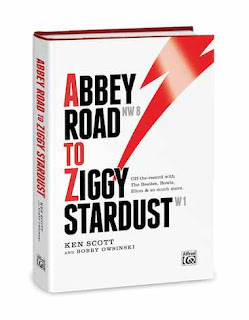--------------------
"One way of looking at how I approached Crime was that it started as Google Earth. I knew the overall shape of it, and as we went along it became more like the Street View as we slowly saw every nook and cranny. The fact was that I was actually bored with recording. I’d recorded drums, guitars, tambourines and everything else you can imagine so many bloody times and it was always the same. Since we were going all out on this record, I decided that we should try to make it as different as we can. I threw that concept at the band, and they just ran with the idea.
Like with the sound effects. Most times when sound effects were used on records back then, the engineer would go to the closet that had the sound effects records or tapes, and that’s what he’d use. Everyone used the same ones. I insisted, “If we’re going to do it, we’re going to do it properly and record our own, exactly like a movie,” so we rented a stereo Nagra portable recorder and recorded all of our own sound effects. For example, for the song “School”, I went down to a friends house that was two doors down from where my three daughters were going to school, just in time for the lunch break because I knew the kids would be out in the yard playing. I recorded for a half hour, then went off to the studio. Roger would then listen on headphones to try to find bits that might actually work in the song, and we’d go through it and finalize what we were going to use.
For percussion we tried to use different things that weren’t typical percussion instruments. On “Dreamer” there’s a part that under normal circumstances would have been a tambourine, but that would’ve made it so ordinary. In trying to get something different, I had the idea of getting Rick [Davies] to shake a pair of drum brushes. He started off doing it rather heavily, but all you could hear was a whistle from them. We got him to slow it down a bit and do it with more wrist than arm action and suddenly we got the effect that we wanted. There’s a kind of whistle there at the same time as the brushes go through the air, which makes it sound totally different than anything you’d expect but still fills the rhythmic need.
Probably one of the best examples of teamwork was when recording some tom overdubs, also on “Hide In Your Shell.” We wanted to get a change in pitch on each tom hit, so every time Bob [Siebenberg, Supertramp's drummer] hit a tom I changed the varispeed, speeding the tape up and then bringing it back to normal. When played back this makes the tom's pitch go down and then as it tails off it goes back up to normal. Bob had to hit the tom on beat with the tempo going all over the place, a feat he accomplished admirably as can be heard on the final product.
Everything but the kitchen sink went into this recording. Actually we got pretty close to a kitchen sink as well. The session percussionist extraordinaire and all around nice guy Ray Cooper had once told me of something which apparently was used a lot in horror movies - a water gong. You take a gong, hit it and then gradually lower it into water. This creates a strange, eery effect because as the gong is immersed the water makes its pitch change. We were working on the ending of “Crime of the Century” and for those that don’t know, “Crime” is in two parts. There’s the song and then it goes into a seemingly endless piano part during which it builds and builds with different instruments and lines coming and going throughout. We were at the point where the drums came in and we needed something to point out that something big was about to happen. Enter the water gong.
Now that name is slightly incorrect because it ended up that we didn’t actually use a gong; we used a piece of sheet metal instead, but it worked just as well. We rented a large fish tank and filled it with water and, at the appropriate time, Bob struck it and lowered it into the water, and it sounded amazing. What’s great is that if you hear it on its own with no other instruments and without any reverb, you actually hear the water bubbling. So cool. That effect actually became a pet thing for me as I used it in one form or another on a number of future albums as well. A word of warning however; the filling of the fish tank is slow but fairly easy to accomplish, one bucket of water at a time. But, once you’ve finished the recording you’re left with one hell of a heavy fish tank to empty and so you have to have a fair number of pretty hefty guys to get it to the kitchen or bathroom sink to empty it.
We went completely overboard on everything, which is why the album took close to six months, a very long time for an album back then. Once we were given that crucial go-ahead from the label, we had no real choice but to strive for perfection."
For more details on what's in the book and to pre-order it, go to abbeytoziggy.com. For more info on Ken, go to Ken-Scott.com.
----------------------------------
You should follow me on Twitter for daily news and updates on production and the music business.
Don't forget to check out my Music 3.0 blog for tips and tricks on navigating social media and the new music business.



No comments:
Post a Comment